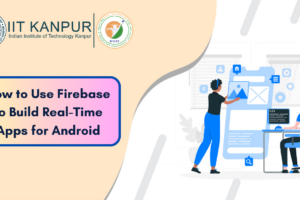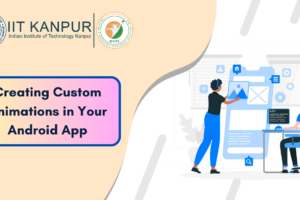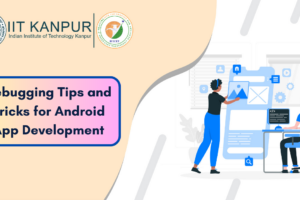Building Your First Android App: A Beginner’s Guide
- Date July 28, 2023
Embarking on the journey of creating your first Android app can be both exciting and overwhelming. With millions of apps available today, needing clarification before bringing your creative concept to life is important. As you begin your journey into Android application development, we will carefully guide you through the necessary methods, utilities, and resources to help you build your first android app from conception to completion.
Define Your App's Purpose
Every successful app begins with a clear purpose. Begin by recognizing the issue your app will solve or the value it’ll give to users. Conduct intensive market research to understand your target audience, their needs, and existing apps within the same category. This information will assist you in refining your idea and identifying special features that set your app apart.
Consider creating user personas to speak to your target audience. These fictional characters embody the characteristics and preferences of your potential users. You can tailor your app’s features and plan to meet their needs by understanding their objectives, challenges, and priorities.
Besides, think about the monetization technique for your app. Will it be free with in-app purchases, offer a membership model, or show advertisements? Understanding the revenue potential and business model early on will impact your improvement decisions.
Choose Your Development Path
Android app development offers different choices, including native development with Java or Kotlin or cross-platform systems like React Native or Flutter. Each approach has its advantages and considerations.
Native development with Java or Kotlin gives full access to Android-specific APIs and libraries, empowering you to construct exceedingly performant and optimized apps. It permits deep integration with the Android platform and access to a vast community and resources.
On the other hand, cross-platform systems like React Native and Flutter give the advantage of writing code once and deploying it across numerous platforms. They offer faster development cycles and can be an incredible choice if you have restricted resources or need to target both Android and iOS platforms simultaneously.
Assess your objectives, skillset, and project requirements to decide your first app’s most suitable development path. Consider components such as performance requirements, time imperatives, team collaboration, and the accessibility of third-party libraries and tools.
Set Up Your Development Environment
It would be best if you prepared your development environment before beginning. Get Android Studio set up, as it is the recommended IDE for creating Android apps. You may test your app on various devices and Android versions with the help of Android Studio’s emulators, compiler, debugger, and editor.
Learn your way around Android Studio’s interface and functions. Check out the XML editor, the code editor, and the Project view. Discover the IDE’s code auto-completion, linting, debugging features, and how to navigate the Android documentation.
Learn the Basics of Java/Katlyn
If you choose native improvement, understanding the basics of Java or Kotlin is essential. These languages serve as the foundation for Android app advancement. Learn the syntax and fundamental concepts of Java or Kotlin to get started. Acquaint yourself with variables, data types, control flow statements, functions, and standards for object-oriented programming (OOP). Acquire an understanding of fundamental concepts, including classes, objects, inheritance, polymorphism, and encapsulation.
To extend your understanding, investigate advanced topics like error handling, multithreading, data persistence, and networking. Understanding Java or Kotlin will empower you to write clean, efficient, and maintainable code for your Android app.
Utilize online tutorials, interactive coding exercises, and example tasks to hone your programming abilities. Join developer communities and forums where you can ask queries, share your progress, and gain knowledge from seasoned developers.
Design User Interface (UI) and User Experience (UX)
A visually appealing and user-friendly UI/UX is pivotal for app success. Start by comprehending the UI/UX design principles and Google’s Android design guidelines. These guidelines will assist you in developing an app that meets user expectations and provides a consistent experience across multiple devices.
Learn the essentials of designing layouts utilizing XML or the Android Layout Editor within Android Studio. Understand the concept of views and view groups and how to position and style them using XML properties or programmatically.
Consider user interactions and navigation within your app. Design intuitive and responsive interfaces that permit users to accomplish tasks efficiently. To improve user engagement and fulfillment, implement appropriate feedback mechanisms, such as animations and visual prompts.
Pay attention to accessibility guidelines to guarantee that your app is usable by people with disabilities. Consider text style sizes, color contrast, and alternative text for images to make your app accessible to a more vast audience.
Implement App Functionality
Once you have a strong understanding of the basics, it’s time to execute the functionality in your app. Start by breaking down your app’s features into smaller modules or components. This secluded approach permits way better organization, reusability, and codebase maintainability.
Learn about activities, which serve as the entry points for user interactions, and how to manage the flow between different activities. Utilize intents to explore between screens and share information between components. Ace the utilization of parts to make adaptable and reusable UI components within your app.
Incorporate APIs and libraries to upgrade your app’s capabilities. Explore features such as data storage utilizing SQLite databases or higher-level abstractions like Room, network communication using libraries like Retrofit or Volley, interactive media handling, camera access, or location services. Utilize the Android framework’s built-in components for features like notifications, background processing, and permissions management.
Consider implementing third-party libraries or open-source projects to use existing solutions for standard functionalities. However, be careful of the libraries’ maintenance status, community support, and compatibility with your chosen development path.
Test and Debug Your App
Thorough testing and debugging are essential to guarantee your app functions as anticipated. Android Studio gives a range of tools and frameworks to help you in this process. Begin by writing unit tests to verify the behavior of individual components in confinement. Utilize the JUnit testing system with Android-specific frameworks like Espresso for UI testing and Mockito for mocking dependencies. Automate your tests to guarantee consistent results and ease the regression testing method as your app evolves.
Integrate your app’s various components and test their interactions. Test the usefulness and dependability of your app by simulating diverse user interactions, edge circumstances, and real-world scenarios. With the help of Android Studio’s emulators and testing tools, you can test your app on various screen sizes, virtual devices, and Android versions.
Getting feedback from real customers or beta testers is also a good idea. Their comments can help identify usability issues and performance constraints. Use crash reporting tools to track and investigate in-field app crashes, providing you with the information you need to resolve stability issues.
Publish Your App
Congratulations! You can now release your app to the public. Ensure your app complies with all of Google Play’s policies before releasing it to the public. Make an icon that stands out and reflects your app’s identity and goals. Create enticing pictures and a video preview of your program highlighting its best features. Create an alluring app description emphasizing your app’s distinctive features and benefits.
Adhere to the Google Play Store’s submission guidelines and ensure your app complies with all applicable laws, ratings, and age restrictions. Get ready for the review procedure, which may require some dialogue with Google’s audit team. Be patient and responsive to criticism or queries to advance the publication timeline.
Conclusion
Creating your first Android app will test your creativity, problem-solving, and technical talents to their limits. Following this beginner’s guide, will help you acquire essential insights into the fundamental steps and considerations for creating an Android app from scratch.ss
Remember that practice, patience, and persistence are essential to becoming an expert Android app developer. Always look for ways to improve your skills, remain abreast of the latest Android developments, and participate in the thriving Android designer community. With commitment and zeal, your first Android app can be the beginning of a rewarding voyage in mobile application development.
Previous post
Application of Reinforcement Learning in Artificial Intelligence: Challenges, Advances, and Future
You may also like

How to Use Firebase to Build Real-Time Apps for Android

Creating custom animation in your Android app


